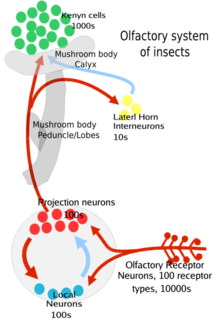Insect olfaction

Insect olfaction refers to the function of
The two organs insects primarily use for detecting odors are the antennae and specialized mouth parts called the maxillary palps.[3] However, a recent study has demonstrated the olfactory role of ovipositor in fig wasps.[4] Inside of these olfactory organs there are neurons called olfactory receptor neurons which, as the name implies, house receptors for scent molecules in their cell membrane. The majority of olfactory receptor neurons typically reside in the antenna. These neurons can be very abundant; for example, Drosophila flies have 2,600 olfactory sensory neurons.[3]
Insects are capable of smelling and differentiating between thousands of
Insects have been used as a
Evolutionary history
Olfaction is metabolically costly. The evolutionary trade-offs involved require further study because as of 2016[update] most such research has been done under laboratory conditions with unrealistically reliable food.[8]
Olfactory cascade
Sensory neurons in the antenna, maxillary palp, and labella generate odor-specific electrical signals called spikes (
Specifically the process is as follows: first the odorant wafts towards an insect's antenna or
These ORNs are bipolar, on one end are the olfactory
Research methods
Action potential recordings are conducted in three different ways electroantenograms, electropalpograms, and single sensillum recordings (SSR).[5] In electroantenograms (EAG) and electropalpograms (EPG) the action potentials from the entire antenna or maxillary palp, respectively, is recorded. EAGs and EPGs provide an overall view of olfaction in the respective organ.[5] During an SSR an electrode is inserted into just one sensillum and the recording is made from only the ORNs which are contained within that sensillum, providing more detailed information[5].
Any of these methods can be combined with a high resolution gas chromatography to isolate volatile compounds from important animals or habitats.[5] For example, this method could be used to determine which compound from a particular flower is the most attractive to a bee. Recordings from projection neurons show that in some insects there is strong specialization and discrimination for the odors presented by the ORNs. This is especially true for the projection neurons of the macroglomeruli, a specialized complex of glomeruli responsible for the pheromones detection.
Repellents and attractants
Humans exploit the insect olfactory system to control agricultural and disease carrying pests.
The art of finding an attractant or repellent for a particular insect of interest is complicated and a long, intensive process. For example, using pheromones only attracts insects in their reproductive stage, a short period in their lives.[2] While scents of food may be attractive to hungry insects they would not be effective in a field full of a crop that is palatable to that insect.[2]
Situationally-dependent attractants / repellents
Insects use the same signal for many different uses depending on the situation this is called chemical parsimony.[5] Situations that may change how an insect behaves in reaction to a scent are things like the concentration of the compound, the life stage of the insect, its mating status, other olfactory cues, the insects feeding state (hungry or full), the time of day, or even the insects body position.[2][3][5] For example, Drosophila are very attracted to apple cider vinegar but in very high concentrations an additional olfactory receptor (that has low affinity for the vinegar, Or85a) is activated which changes the fly’s behavior from attraction to aversion.[3] These different behaviors to the same cue is called behavioral plasticity.[2]
Carbon dioxide
Many insects are capable of detecting very minute changes in the concentration of CO2.[5] While CO2 has been found to be an attractant in every arthropod studied[5] and it is very important in mosquito monitoring and control, even this stereotyped reaction can be plastic. Drosophila avoid CO2 when walking but move towards it when in flight.[3]
DEET
Many insects (and other arthropods) have been shown to avoid areas containing N,N-diethyl-3-methylbenzamide or DEET. They innately avoid DEET, likely because it is a “confusant” that stimulates gustatory, ionotropic, and olfactory receptors and “distorts” other odorants interaction with those receptors.[3]
